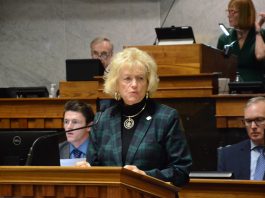AG concludes inspection tour of river, meets with local conservation groups
NEW HARMONY, Ind. – To raise awareness about the risk that invasive fish pose to the Wabash River ecosystem and native fish, Indiana Attorney General Greg Zoeller today concluded his four-day tour and inspection by boat of the Wabash River where he met with local conservation groups to listen to concerns and share information about the Asian carp’s spread into Indiana waterways.
Today, the final day of his Wabash River tour, Zoeller stopped in New Harmony and discussed Asian carp encroachment with local residents, groups and officials. Earlier in the week, Zoeller was joined on the tour by John Goss, director of the federal government’s Asian Carp Regional Coordinating Committee, part of the White House Council on Environmental Quality.
“We all want to protect the Great Lakes from future problems with Asian carp but need to recognize the current environmental problems currently being caused by this invasive species. I appreciate Director Goss – a Hoosier himself – and our federal partners for their help in the effort to protect and preserve the quality of our rivers and streams for those of us who enjoy fishing, boating and recreation along the Wabash River,†Zoeller said today in New Harmony in Posey County.
Launching on Monday from Wabash, Ind., Zoeller and Goss traveled on a borrowed speedboat downriver to Peru, Ind., and discussed the invasive fish with members of the Wabash River Heritage Corridor Commission, before Goss disembarked. Zoeller then proceeded though Logansport, Lafayette, Clinton, Terre Haute, Merom and Vincennes, traveling most of the way by boat, finally arriving at New Harmony, which is a distance of approximately 334 river miles from the launch point.
The non-native Asian carp, including silver carp and bighead carp, have spread northward up the Mississippi River since they were inadvertently released from fish hatcheries in the South in the 1970s. Two populations of Asian carp are known to inhabit segments of the Wabash River. If the voracious carp become more widely established in Indiana waterways and the Great Lakes and compete for plankton, they could disrupt the food chain and displace native fish species, and that could harm the recreational and commercial fishing industries. The largest of the Asian carp can grow to four feet long and 90 pounds, and the silver carp’s characteristic of jumping out of the water in large numbers at the sound of passing outboard motors can potentially injure boaters. Zoeller observed Asian carp jumping from the water Tuesday near Lafayette, Ind.
In February 2010, Attorney General Zoeller, representing Indiana, filed an amicus brief in the United States Supreme Court in the State of Michigan’s legal dispute with the State of Illinois over Asian carp control methods. The brief urged the Court to exercise its original jurisdiction in the case, but ultimately the nation’s highest court declined to hear the dispute. To prevent the spread of the carp into Lake Michigan, the U.S. Army Corps of Engineers currently operates electric barriers in waterways outside Chicago, and a chain-link fence was installed across Eagle Marsh near Fort Wayne to prevent the invasive fish from spreading through Maumee River tributaries into Lake Erie.
In light of ongoing discussion in Illinois and other Great Lakes states about a proposal to separate Lake Michigan from Chicago waterways to halt the northward advance of the fish, Zoeller said he wants to ensure that the concerns of Hoosier stakeholders – particularly those in affected communities on the banks of the Wabash – are heard by the federal government and that Indiana does not face an unfair cost burden in the process.
“We are concerned about the costs to Indiana of controlling this aquatic pest whose spread was not caused by the citizens of Indiana,†Zoeller said.
Zoeller chose the City of Wabash as the launching point of his river tour Monday to highlight the river’s economic and cultural importance to local communities and also note the role of the Indiana Attorney General’s Office by statute in bringing certain environmental litigation on the State’s behalf and in legally representing state agencies such as the Indiana Department of Environmental Management and Department of Natural Resources. For example, the Attorney General’s Office recently assisted the City of Wabash by obtaining a search warrant for a 20-acre former industrial site where potentially hazardous substances were located, and information gathered in the warrant search will be useful in directing a cleanup of the site.
A volunteer provided the use of his Zodiac boat and piloting it down the Wabash during the river tour that concluded near the New Harmony Inn. (Not all the trip was by water, the boat had to be hauled out and towed to a few locations due to water level.) Water quality was another focus of the river inspection tour. Zoeller noted a program operated with the assistance of volunteers, Hoosier Riverwatch, allows the public to monitor river water quality and pollution sources and report issues with the Wabash River to the Indiana Department of Environmental Management or IDEM at http://www.hoosierriverwatch.com/.
NOTE: Photos and video of Asian carp can be downloaded from the multimedia page of the Asian Carp Regional Coordinating Committee of the White House Council of Environmental Quality, at this link: http://www.asiancarp.us/multimedia.htm#photos




